I'm trying to implement the method of improving fingerprint images by Anil Jain. As a starter, I encountered some difficulties while extracting the orientation image, and am strictly following those steps described in Section 2.4 of that paper.
So, this is the input image:

And this is after normalization using exactly the same method as in that paper:

I'm expecting to see something like this (an example from the internet):

However, this is what I got for displaying obtained orientation matrix:

Obviously this is wrong, and it also gives non-zero values for those zero points in the original input image.
This is the code I wrote:
cv::Mat orientation(cv::Mat inputImage)
{
cv::Mat orientationMat = cv::Mat::zeros(inputImage.size(), CV_8UC1);
// compute gradients at each pixel
cv::Mat grad_x, grad_y;
cv::Sobel(inputImage, grad_x, CV_16SC1, 1, 0, 3, 1, 0, cv::BORDER_DEFAULT);
cv::Sobel(inputImage, grad_y, CV_16SC1, 0, 1, 3, 1, 0, cv::BORDER_DEFAULT);
cv::Mat Vx, Vy, theta, lowPassX, lowPassY;
cv::Mat lowPassX2, lowPassY2;
Vx = cv::Mat::zeros(inputImage.size(), inputImage.type());
Vx.copyTo(Vy);
Vx.copyTo(theta);
Vx.copyTo(lowPassX);
Vx.copyTo(lowPassY);
Vx.copyTo(lowPassX2);
Vx.copyTo(lowPassY2);
// estimate the local orientation of each block
int blockSize = 16;
for(int i = blockSize/2; i < inputImage.rows - blockSize/2; i+=blockSize)
{
for(int j = blockSize / 2; j < inputImage.cols - blockSize/2; j+= blockSize)
{
float sum1 = 0.0;
float sum2 = 0.0;
for ( int u = i - blockSize/2; u < i + blockSize/2; u++)
{
for( int v = j - blockSize/2; v < j+blockSize/2; v++)
{
sum1 += grad_x.at<float>(u,v) * grad_y.at<float>(u,v);
sum2 += (grad_x.at<float>(u,v)*grad_x.at<float>(u,v)) * (grad_y.at<float>(u,v)*grad_y.at<float>(u,v));
}
}
Vx.at<float>(i,j) = sum1;
Vy.at<float>(i,j) = sum2;
double calc = 0.0;
if(sum1 != 0 && sum2 != 0)
{
calc = 0.5 * atan(Vy.at<float>(i,j) / Vx.at<float>(i,j));
}
theta.at<float>(i,j) = calc;
// Perform low-pass filtering
float angle = 2 * calc;
lowPassX.at<float>(i,j) = cos(angle * pi / 180);
lowPassY.at<float>(i,j) = sin(angle * pi / 180);
float sum3 = 0.0;
float sum4 = 0.0;
for(int u = -lowPassSize / 2; u < lowPassSize / 2; u++)
{
for(int v = -lowPassSize / 2; v < lowPassSize / 2; v++)
{
sum3 += inputImage.at<float>(u,v) * lowPassX.at<float>(i - u*lowPassSize, j - v * lowPassSize);
sum4 += inputImage.at<float>(u, v) * lowPassY.at<float>(i - u*lowPassSize, j - v * lowPassSize);
}
}
lowPassX2.at<float>(i,j) = sum3;
lowPassY2.at<float>(i,j) = sum4;
float calc2 = 0.0;
if(sum3 != 0 && sum4 != 0)
{
calc2 = 0.5 * atan(lowPassY2.at<float>(i, j) / lowPassX2.at<float>(i, j)) * 180 / pi;
}
orientationMat.at<float>(i,j) = calc2;
}
}
return orientationMat;
}
I've already searched a lot on the web, but almost all of them are in Matlab. And there exist very few ones using OpenCV, but they didn't help me either. I sincerely hope someone could go through my code and point out any error to help. Thank you in advance.
Update
Here are the steps that I followed according to the paper:
- Obtain normalized image G.
- Divide G into blocks of size wxw (16x16).
- Compute the x and y gradients at each pixel (i,j).
Estimate the local orientation of each block centered at pixel (i,j) using equations:

Perform low-pass filtering to remove noise. For that, convert the orientation image into a continuous vector field defined as:


where W is a two-dimensional low-pass filter, and w(phi) x w(phi) is its size, which equals to 5.
- Finally, compute the local ridge orientation at (i,j) using:

Update2
This is the output of orientationMat after changing the mat type to CV_16SC1 in Sobel operation as Micka suggested:


